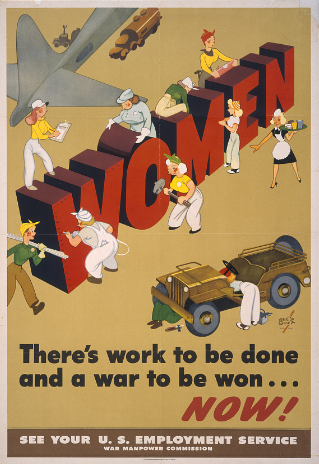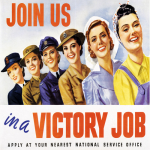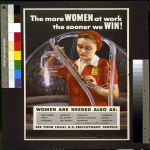The primary source is a poster that was created in 1944 and it is titled “Women: There’s work to be done and a war to be won … Now! See your U.S. Employment Service // Vernon Grant for OWI.” The cartoon is showing women working on and building the word “Women” as well as working on a jeep. In the cartoon, there is also a plane and a truck in the background. Each of the women is dressed differently to represent different professions and roles they are to take on as employment during the wartime. There are women dressed as bakers, maids/waitresses, construction workers, mechanics, supervisors, and many more jobs. Overall, it shows women dressed as many different working positions to represent that there were many new employment opportunities for women now that the men were going away.
This poster was recruiting women for work because there was a war going on and the men needed to go fight, so the women had to work. Prior to the war, women were seen as housewives and stay at home moms, taking care of the household, the children, and the working husband. However, now that war needs to be won and all the men are needed to go fight it and win it, women are being recruited to work the “manly” jobs that only men have been allowed to work for so long. Many of the men during that time period contested against women taking over traditionally male jobs[1]. Because for so long it was societally unacceptable and not allowed for women to do anything besides stay at home and take care of everyone. One of the male legislators, who became disgruntled by the idea of women taking on traditionally male jobs, was asking “Who will do the cooking, the washing, the mending, the humble homey tasks to which every woman has devoted herself; who will rear and nurture the children?”[2] This shows that women were seen as housewives and were expected to enjoy cooking, cleaning, and taking care of the house and children, and their working husbands. Women were eager to stop being housewives and taking care of the house, children, and husband, and go into the world and make some money. Many women never dreamed they would be able to escape the tiring routine of domestic life to go and work what is considered a manly job and earn a wage. A woman welder said that her wartime job was “the first time [she] had a chance to get out of the kitchen and work in the industry and make a few bucks” [3] Although there was a war and it wasn’t exactly a great thing for the country and the men fighting, it was a great opportunity for these women to go out into the industry and work and earn money. Especially to be working a job considered to be traditionally male, was a great accomplishment and stride for women during the time period.
Many women, once their husbands returned home from the war went back to being housewives, but a good number of women decided to continue working and seek a career. Claudia Goldin in “The Role of World War II in the Rise of Women’s Employment” wrote that “although it is clear that many women who entered the labor force during the war left at its conclusion, it is not obvious that they left permanently.” [4] This shows that many women did not want to leave the workforce. Some women, however, did want to leave, and some were forced into leaving. “Yet, management, with the cooperation of unions, laid-off women workers at rates that were far higher than the lay-off rates for men” [5] Since their husbands were gone women got to work jobs previously known as male, and now had to become the provider for their families. In the journal article by Marc Miller, “Working women and World War II” the author states that “contrary to myth, women workers, especially during the war, used their paychecks not as “pin money,” but to support themselves and their families” [6] They were working to take care of their families, but many women enjoyed it and wanted to continue working and start a career. Women were working before the war, but the war gave women more opportunities to work different jobs, especially those that were considered to be traditionally male jobs. According to Claudia Goldin, “just 20 percent of those working in 1950 had entered the labor force during World War II, and about half the wartime entrants left the labor force some- time after December 1944” [7] According to this journal, half of the women stayed in the workforce and the other half had left their jobs. The wartime gave women a chance to take over the jobs a male would normally have and to provide for their family. Many women excelled at these jobs and it was a great opportunity and growth for women at that time.
[1] Shi, David Emory. America: a Narrative History. New York: W.W. Norton & Company, 2019, 1076
[2] Shi, David Emory. America: a Narrative History. New York: W.W. Norton & Company, 2019, 1076
[3] Shi, David Emory. America: a Narrative History. New York: W.W. Norton & Company, 2019, 1076
[4] Goldin, Claudia D. “The Role of World War II in the Rise of Women’s Employment.” The American Economic Review 81, no. 4 (1991): 741-56
[5] Kossoudji, Sherrie A., and Laura J. Dresser. “Working Class Rosies: Women Industrial Workers during World War II.” The Journal of Economic History 52, no. 2 (1992): 431-46
[6] Miller, Marc. “Working Women and World War II.” The New England Quarterly 53, no. 1 (1980): 42-61
[7] Goldin, Claudia D. “The Role of World War II in the Rise of Women’s Employment.” The American Economic Review 81, no. 4 (1991): 741-56
Below are some images that represent and display women working during WWII.
All images were found on from a simple google search.




